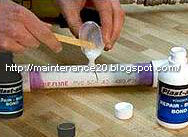How to unblock a drain
How to unblock a drain
Unclogging a properly blocked drain (depending on the drain) isn't usually a fun job. At its worst, it ranks somewhere between finding a three-week-old bag of prawns in the back of your fridge and changing nappies in terms of unpleasantness. Blocked drains don't get that way overnight, and can often be the result of months of accumulated muck and detritus.
Once a drain is blocked, it must be unclogged or the drain is useless, and water will start backing up. Sometimes a drain just needs a little nudge along, but other times it will take more work. And when it is properly blocked, there is no other choice but to go in; you can’t decouple a bath or shower pipe in the same way as you can with a sink drain. Gloves are highly recommended.

A drain snake can be used to clear many kinds of obstructions.
Stage one: Try a plunger
Start by clearing the area of anything covering the drain, and any other bathroom or kitchen gear (including bath mats, strainer attachments, soap dishes and toothbrushes). There are a few things you can try before things get too nasty. Start by using a plunger, being careful to fully cover the drain opening. Run some water until there is enough to create suction. Plunge a few times then gently remove the plunger to see if water will run freely. Keep repeating for a while, but if it won’t run, let the water settle and move on to step 2.
Step 2: Hair removal cream
Yes, hair removal cream. Pour some into the drain, let it sit for around 30 minutes, and then try flushing the drain again. Most shower clogs are caused by hair, and even if you don't use it for anything else, hair removal cream is great to keep around for this purpose. If you don't have any handy, move on to step 3.
Step 3: Bicarb soda
If the hair removal cream didn't work, there is still one last thing you can try. Allow the water to settle as much as possible, then tip a cup of bicarb soda slowly into the drain, and follow it with around the same quantity of vinegar. Immediately place a wet rag over the top of the drain to seal it off. The bicarb and vinegar will react and create a lot of foam, which you don’t want to seep out and spread all over the place - instead, you want it to push back into the pipe where it might be able to clear the blockage. Once the pressure subsides, leave it to settle for around 30 minutes, then flush it through. Repeat a few times if necessary.
Step 4: The manual approach
If all else fails, you’re going to need to get physical. A drain snake is the ideal option here, but if you don’t have one you can also twist a wire coat hanger open, stretch it out and bend a hook in the end to create a makeshift snake of your own. Remove the drain protector if you can, but don’t force it if it won’t come out. Clear out any hair you can reach with your fingers and dispose of it. Slowly push the drain snake or hook down the drain until you encounter resistance, then slowly bring it back up. Remove as much of the clog as you can and flush the drain regularly, repeating as many times as you need to. Don’t push hard if you’re using a coat hanger; you don’t want to rupture the pipe.
If this still doesn’t clear the blockage, then call a plumber. Heavy duty drain cleaners can be used, but they can sometimes clog the pipe worse if they're not used properly. Regular maintenance of drains is encouraged to avoid this problem from arising.

Sounds Good
ReplyDeleteNice blog, i like to read this article. Thanks for sharing this information.Drain Unblocking Auckland
Sounds Good
ReplyDeleteNice blog,, This blog is very informative. Thanks for sharing this information.fast drain unblocking
Sounds good
ReplyDeleteNice blog, This blog is very informative. Thanks for sharing this information. Cheap plumbers auckland
ReplyDeleteSounds good
Nice blog, This blog is very informative. Thanks for sharing this information. Drain unblocking north shore
ReplyDeleteThanks for sharing the information and keep on updating us regularly.
Blocked Drains Melbourne | Blocked Stormwater Drains Melbourne